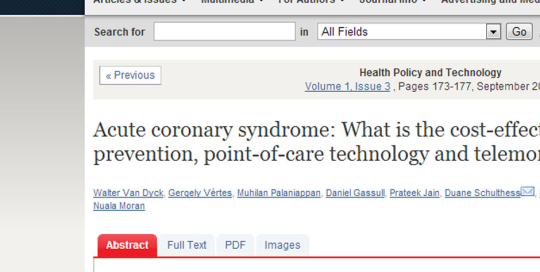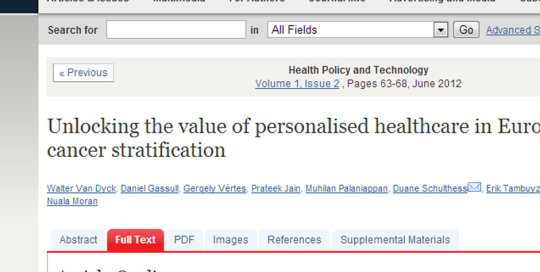Acute coronary syndrome - What is the cost-effectiveness of prevention, point-of-care technology and telemonitoring? This study is a cost-analysis that calculates the impact of three interventions for patients identified as ‘at risk’ for Acute Coronary Syndrome - a cardio-vascular exercise programme, point-of-care digital diagnostics, and telemonitoring adherence tools. The methodology utilizes a model of the annualized costs of ACS for the entire treatment value chain, and measures the impact of the three interventions by the change in treatment cost, incremental net benefit, and QALY. The results demonstrate that the largest impact is measured when all three interventions are utilized simultaneously producing a cumulative savings of €4424 and 0.126 QALY per patient . We also find a significant decrease in Emergency Room visits by 15% and changes in rates of utilization of Catharization (−59%), Angioplasty (−59%), Bypass (−17%), Medication (−14%) and Rehabilitation (−13%). Highlights Incidence of ACS can be significantly reduced with exercise, diagnostics, and adherence. ll three interventions produce a cumulative savings of €4424 and 0.126 QALY per patient. Reductions in Emergency Room visits −15%, Catharization −59%, Angioplasty −59% and Bypass −17%.
RESEARCH: Breast cancer stratification
Unlocking the value of personalised healthcare in Europe — breast cancer stratification Through stratification, this simulation shows that there is great potential to improve the efficiency of treating breast cancer. By segmenting the female population at the age of 50 based on family history and genetic testing, our model shows a reduction in costs of breast cancer treatments by 37% with no loss of efficacy accomplished primarily through a 60% drop in incidence of metastatic stages of the disease. These programmes are not inexpensive, and require substantial upfront investments of roughly 2 billion GBP and continued annual investments of several hundred million GBP. However, our simulations show a positive NPV and ROI in approximately year 7 of the programme. Highlights Reduces total patient cost of healthcare by 37% without affecting average QALY. Reduces the incidence of metastatic stages of the disease by 62%. Pay-back is achieved in 6–8 years and savings climb up to 3b£ in the UK over 25 years.


